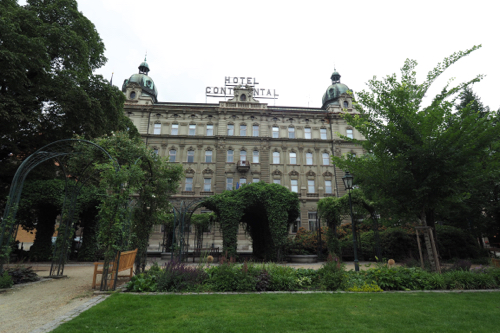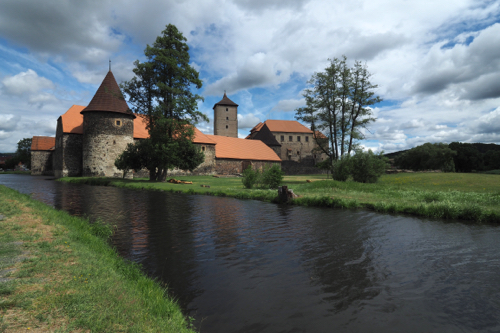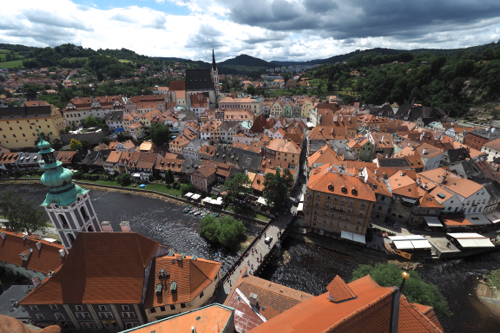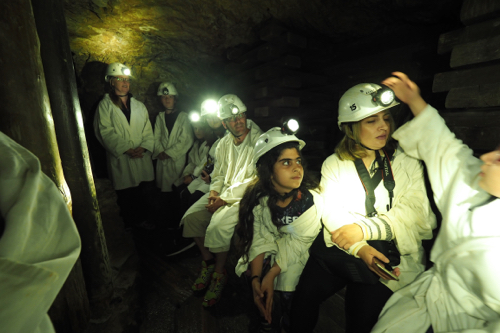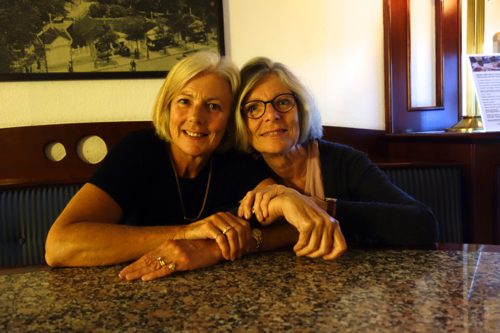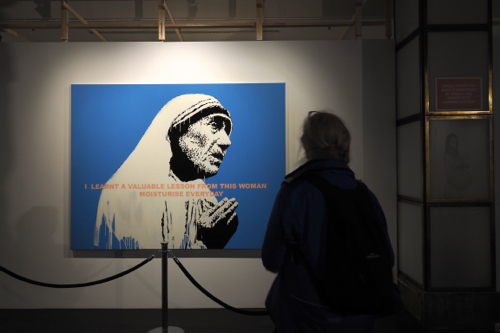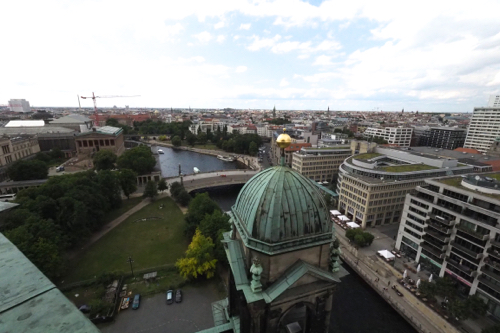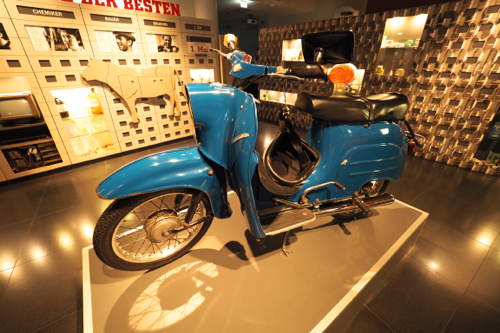June 29, 2017. Kreuzwertheim, Germany to Pilsen, Czech Republic.
The windscreen wipers on the Opel Mokka didn’t stop for the entire trip from Kreuzwertheim in Germany to Pilsen in the Czech Republic. The first stop on our adventure to Eastern Europe.
The hold-ups, due to roadworks, were almost as relentless as the rain along the 340 km route.
In the late afternoon we walked around Pilsen, the birthplace of Pilsner Urquell, the Czech Republic’s distinctive, bottom-fermented lager. It’s regarded as one of the best beers in the world and having it in it’s unfiltered form, they might be right.
Dinner was at U Salzmannū, established in 1637, it’s the world’s oldest Pilsen Beer House.
Not to be outdone by the beer, the wine we had at dinner came from the Habánské Vineyard, Morava, which was established in 1614.
Prices were also from another era. Our dinner at U Salzmannū only cost us A$45. I’ve not had a meal that cheap since the 80s’.
June 30, 2017. Pilsen, Czech Republic.
Pilsen, apart from beer, has a long history dating back to 1295 when it was established by ‘Good’ King Wenceslas II.
Our hotel, the Continental, was metres from the main town square, so everything was accessible.
School had recessed for the Summer and kids were everywhere. There was even a small fun-fair in the square.
We had lunch at Švejk, a chain of Czech restaurants.
The character featured on the restaurant livery is inspired by an unfinished, dark and satirical comedy (The Good Soldier Švejk) by Jaroslav Hašek. In the 1920s the character was carved, as a puppet, by Gustav Nosek, manipulated by Ludva Novák, voiced by Josef Skupa and performed in the puppet theatre of Pilsen.
Now this weird, distorted face is everywhere in the restaurant.
Menus, signage, crockery, even the base of the chairs features Švejk.
In the afternoon we visited the Puppet Museum, which is at one end of the town square.
Puppets, like ventriloquist dolls, are to my mind spooky, out-of-this-world beings.
The Puppet Museum in Pilsen contains hundreds of them.
They ranged in size from miniature decorations, for your beer stein, to larger than life giants of the small stage.
In the evening, after the children had gone home, the big kids came out to play.
There must have been a football match on somewhere locally or on TV.
The police were patrolling the streets as were the young men in their sports cars.
The vehicles ranged from old Mustangs to new Mercedes, with a lot of ‘try-hards’ in between.
Apart from the famous Pilsner Urquell and Gambrinus Breweries, there are at least four craft breweries in the Pilsen area.
Unfortunately you have to go to them to have a tasting and we just didn’t have enough time.
July 1, 2017. Pilsen to Český Krumlov, Czech Republic.
On the drive to Český Krumlov we made a stop at Švihov Castle. A crumbling edifice with a moat on two sides.
This Medieval castle was built between 1480 and 1510 and was the seat of the Lords of Rýžemberk.
Our next stop was at Klatovy. We arrived around midday and the wedding parties were lined up at the town hall waiting to be ‘processed’.
The weddings were preceded by a procession of cars, honking their horns as they drove around the town square before stopping at the registry office.
One couple even did a circuit, in a large blue Mercedes Benz prime mover, after their ceremony.
We arrived in Český Krumlov mid afternoon, on Saturday, and finding our accommodation wasn’t without its difficulties. The centre of town was predominantly a pedestrian area, so we had to negotiate the crowds of tourists, winding unmarked streets and the fact that our Pension didn’t have any signage.
Český Krumlov is built on several bends of the Vltava River, making it difficult to get your bearings.
It is certainly popular with tourists, both local and international.
Many of the international visitors vanished in the evening as they had only been in the town on a day trip from Prague, Vienna or Salzburg.
July 2, 2017. Český Krumlov, Czech Republic.
Český Krumlo is regarded as one of the most beautiful historic towns in Europe.
The settlement was built below the castle which was erected around 1240. The Castle was first mentioned in history as Chrumbenowe in 1253. This means ‘Crooked meadow’ in Middle High German, after a bend in the Vltava River.
Český Krumlov was made a UNESCO World Heritage site in 1992 and is best known for the castle. The castle has Gothic, Renaissance and Baroque elements and literally towers over the township.
We visited the Castle Museum, which chronicled the daily life of the the families that lived in the castle.
One interesting fact was that the lady of the house had complete control of its running. She even attended a school to learn how to cope with the very demanding task of its day-to-day management.
A far cry from the British aristocracy.
Another surprising fact was that some noble families were given the right to mint their own coins. Many of these were on display. These became the common means of payment from the 15th to the 18th centuries
The Rosenbergs, Eggenbergs and Scwarzenbergs, of Český Krumlov, had that privilege.
We had dinner at Two Mary’s, a traditional Bohemian restaurant. There were lots of grains, millet and potatoes. It was certainly one of the most interesting meals we have had – so far.
We then had a night cap at Hospoda Na Louži Hotel, a very local local. This Renaissance building first popped up in the history books in 1459.
The patrons were singing, but not much better than Thea and me. However they were incredibly enthusiastic and everyone had song books, plus they all knew the words.
It was a great atmosphere, a lot like you used to find in English working class pubs of the 1970s’.
Much to my delight the walls were covered with old tin advertising posters from the 40s and 50s.
July 3, 2017. Český Krumlov to Kutná Hora, Czech Republic.
We broke the journey to Kutná Hora with a stop in Telč, another UNESCO World Heritage Site.
The town was built around a group of small lakes and originally inhabited in the 13th century.
It’s main attraction is the huge, Zachariáš of Hradec Town Square.
It is surrounded by heavily decorated Renaissance buildings, painted in pastel colours.
Despite its grand romantic history there is even a Švejk restaurant just off the square.
The man is omnipotent.
We had about a 45 minute hold up on route. It turned to be nothing more than a set of traffic lights.
In the evening we had a walk around town of Kutná Hora, and then gravitated to the main square for dinner.
There were many nationalities there but one guy stood out – he had a baseball cap on.
Yes, he was American.
Ten minutes later a group of five arrived at the restaurant. Two of the women were seriously obese.
Yes, they were Americans.
July 4, 2017. Kutná Hora, Czech Republic.
This is the day that we were ‘reliably informed’, we should get our Renault Eurodrive vehicle.
That didn’t happen.
A driver was sent from Paris to Frankfurt, on the train, to pick up our car and drive it to us.
When he got to Frankfurt he found that the number plates still hadn’t arrived, so he had to return to Paris, again on the train.
We were then told that we would get the car the next day in Olomouc.
Considering the distance between Frankfurt and Olomouc is approximately 750km and he wasn’t leaving Frankfurt until 2pm, we weren’t holding our breath.
Kutná Hora is described as the ‘Town of Two Cathedrals’.
The Cathedral of Assumption of Our Lady and Saint John the Baptist at Sedlec, founded in 1142 and the Cathedral of Saint Barbara are both UNESCO World Heritage Sites.
Saint Barbara Cathedral was a fine example Late Gothic architecture, with magnificent flying buttresses supporting a lofty interior, 30m high. Construction started in 1388 but wasn’t finally completed until 1905.
Construction was interrupted for 60 years by the Hussite Wars. However the main hinderance to the building program, and its final size, was the wavering prosperity of the town’s silver mines.
As mining was such an important part of Kutná Hora we visited the Saint George Mine at the Hrádek Museum. This was an excellent display showing construction and renovation from 1388 to present day.
Silver mining in Kutná Hora took place between the 13th and 16th centuries. It’s primary purpose was to mint silver and copper coins. Within that time 2,500 tonnes of silver and 20,000 tonnes of copper were extracted from the mine.
After dinner at a local restaurant, that specialised in Bohemian cuisine, we walk down to the cathedral viewing point. This overlooks the Vrchlice River valley.
Both Saint Barbara Cathedral and the Jesuit College were illuminated and stood out magnificently against the stormy night sky.
July 5, 2017. Kutná Hora to Olomouc, Czech Republic.
We had purchased a combined ticket to see the three main UNESCO sites in Kutná Hora, so on our way to Olomouc we visited the other two.
The Cathedral of Assumption of Our Lady and Saint John the Baptist and the Cemetery Church of All Saints with the Ossuary.
Built in 1142, this is the site of first Cistercian abbey in Czechoslovakia.
The Scwarzenbergs, who had a lot of influence in Český Krumlov Castle, also played a big part in the restoration and expansion of the Cathedral of Assumption of Our Lady and Saint John the Baptist.
Our next stop was the Cemetery Church of All Saints with the Ossuary is also known as the ‘The Bone Church’
Skeletal remains hang from the walls and ceiling as well as in the chapel niches.
It was not surprising, given the macabre nature of the place, that it was far more crowded than the cathedral, just up the road.
There is even a skull and crossbones adorning the church spire.
The church was built in the 14th century and legend has it that a local abbot brought in soil from Jerusalem and by scattering around the cemetery made the place a ‘holy field’.
After the plague of 1318 around 30,000 bodies were buried there and a further 10,000 were also interned as a result of the Hussite wars.
In the 15th century the bones were exhumed and placed inside the church.
The current bone arrangements dates from 1870 and done by a Czech woodcarver, Franttišek Rint.
I had complete forgotten about paying to use the toilet, until we got into the Czech Republic.
I guess 30 cents is a small price to pay for a clean, well maintained, WC.
And, unlike the USA, there are plenty of them.
I would have thought that the idea of a ‘Washroom’ that you pay for would appeal to the American ideal of enterprise.
Our travels took us from Bohemia to Olomouc in Moravia and again we found a restaurant serving the local cuisine.
We were hoping to sit outside on Moravská’s heated terrace, but that was full.
It was excellent food and great service and we found ourselves the last to leave – again.
People do seem to eat early.
When we left the streets were deserted, which was strange considering it was a public holiday.
July 6, 2017. Olomouc, Czech Republic.
Again we were told that the Renault would be arriving.
We were a little more hopeful as this information was coming from the driver, who was on the road from Frankfurt.
We were still in the Czech Republic and staying in the centre of Olomouc an old, historic town.
There was a lot to see but until we had the car we didn’t want to move too far from the hotel.
At 12:30 pm the Renault finally arrived.
It was only then, when we were doing the handover of the Opel Mokka, that we discovered it didn’t have a spare wheel.
We wished Jeanne good luck as he started the long drive back to Frankfurt.
We just hoped that he didn’t get a flat tyre.
Now that we had our hands on the Renault we went about exploring Olomouc – on foot.
The town was a work in progress, with construction and road closures at almost every turn.
We found this out when we arrived
It is believed that Olomouc was originally built over a Roman fort from the late 2nd century.
The city is known for its six Baroque fountains, many featuring gods from Greek mythology, and its columns. The most important is the 35 meters high Holy Trinity Column, which is a UNESCO site and situated in the largest town square, Horní Námēstí.
Unlike other European cities, who removed their fountains after building water supply piping, Olomouc kept theirs as reservoirs in case of fire.
Tipping in the Czech Republic is a strange system.
The locals don’t tip. But the tourists can be tricked into giving a tip by those waiters that understand the silly US system.
If you speak English, you must be an American, seems to be the approach.
I really liked the unfiltered Pilsner Urquell Pilsen but the Chomout Pivo in Olomouc was better.
Chomout, a family run craft brewery, was started in 2014 and has a brewpub right next door to the brewery. There are always six beers on tap, Destíka, Pale larger, Ležál Amber Larger, two American style ales and two seasonal beers.
I had the Režná Bára, a full bodied IPA made from American hops. This beer had recently been voted as the best IPA in the Czech Republic.
I agreed with the judges.
July 7, 2017. Olomouc to Brno, Czech Republic.
It was meant to be a short drive to Brno to catch up with Kate and Mark for a night.
Due to interminable road works it turned out to be longer than anticipated.
The rather round about way gave me an opportunity to ‘test drive’ the Renault.
It was lunchtime when we reached Brno, so after a coffee for me and a quick bite for the others we set out to explore the town.
There’s the castle and cathedral but not a huge amount more, so we managed to do a superficial tour in a few hours.
Kate and Mark had booked a restaurant for dinner and also found a couple of brewpubs for a pre dinner beer, and a wine of course. Nejepši Pub v ČR was a trendy bar with great beer and wine.
After all Moravia is the heart of the Czech wine growing region.
To my mind the Nejepši Pub v ČR had one of the great brewpub logos. A guy with a beer baby belly and a graphic of a foaming pint mug superimposed over the top.
